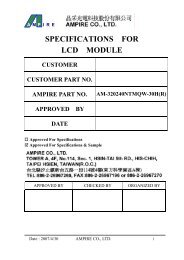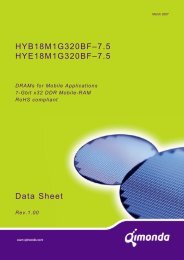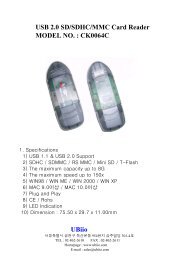Create successful ePaper yourself
Turn your PDF publications into a flip-book with our unique Google optimized e-Paper software.
Internet Data Sheet<br />
HY[B/I]18T256[40/80/16]0B[C/F](L)<br />
256-Mbit Double-Data-Rate-Two SDRAM<br />
11) t CKE.MIN of 3 clocks means CKE must be registered on three consecutive positive clock edges. CKE must remain at the valid input level the<br />
entire time it takes to achieve the 3 clocks of registration. Thus, after any CKE transition, CKE may not transition from its valid level during<br />
the time period of t IS + 2 x t CK + t IH .<br />
12) DAL = WR + RU{t RP (ns) / t CK (ns)}, where RU stands for round up. WR refers to the tWR parameter stored in the MRS. For t RP , if the result<br />
of the division is not already an integer, round up to the next highest integer. t CK refers to the application clock period. Example: For<br />
DDR2–533 at t CK = 3.75 ns with t WR programmed to 4 clocks. t DAL = 4 + (15 ns / 3.75 ns) clocks = 4 + (4) clocks = 8 clocks.<br />
13) t DAL.nCK = WR [nCK] + t nRP.nCK = WR + RU{t RP [ps] / t CK.AVG [ps] }, where WR is the value programmed in the EMR.<br />
14) Input waveform timing t DH with differential data strobe enabled MR[bit10] = 0, is referenced from the differential data strobe crosspoint to<br />
the input signal crossing at the V IH.DC level for a falling signal and from the differential data strobe crosspoint to the input signal crossing<br />
at the V IL.DC level for a rising signal applied to the device under test. DQS, DQS signals must be monotonic between V IL.DC.MAX and<br />
V IH.DC.MIN . See Figure 9.<br />
15) t DQSQ : Consists of data pin skew and output pattern effects, and p-channel to n-channel variation of the output drivers as well as output<br />
slew rate mismatch between DQS / DQS and associated DQ in any given cycle.<br />
16) These parameters are measured from a data strobe signal ((L/U/R)DQS / DQS) crossing to its respective clock signal (CK / CK) crossing.<br />
The spec values are not affected by the amount of clock jitter applied (i.e. t JIT.PER , t JIT.CC , etc.), as these are relative to the clock signal<br />
crossing. That is, these parameters should be met whether clock jitter is present or not.<br />
17) Input waveform timing t DS with differential data strobe enabled MR[bit10] = 0, is referenced from the input signal crossing at the V IH.AC level<br />
to the differential data strobe crosspoint for a rising signal, and from the input signal crossing at the V IL.AC level to the differential data strobe<br />
crosspoint for a falling signal applied to the device under test. DQS, DQS signals must be monotonic between V il(DC)MAX and V ih(DC)MIN . See<br />
Figure 9.<br />
18) If t DS or t DH is violated, data corruption may occur and the data must be re-written with valid data before a valid READ can be executed.<br />
19) These parameters are measured from a data signal ((L/U)DM, (L/U)DQ0, (L/U)DQ1, etc.) transition edge to its respective data strobe signal<br />
((L/U/R)DQS / DQS) crossing.<br />
20) t HP is the minimum of the absolute half period of the actual input clock. t HP is an input parameter but not an input specification parameter.<br />
It is used in conjunction with t QHS to derive the DRAM output timing t QH . The value to be used for t QH calculation is determined by the<br />
following equation; t HP = MIN (t CH.ABS , t CL.ABS ), where, t CH.ABS is the minimum of the actual instantaneous clock high time; t CL.ABS is the<br />
minimum of the actual instantaneous clock low time.<br />
21) t HZ and t LZ transitions occur in the same access time as valid data transitions. These parameters are referenced to a specific voltage level<br />
which specifies when the device output is no longer driving (t HZ ), or begins driving (t LZ ) .<br />
22) Input waveform timing is referenced from the input signal crossing at the V IL.DC level for a rising signal and V IH.DC for a falling signal applied<br />
to the device under test. See Figure 10.<br />
23) Input waveform timing is referenced from the input signal crossing at the V IH.AC level for a rising signal and V IL.AC for a falling signal applied<br />
to the device under test. See Figure 10.<br />
24) These parameters are measured from a command/address signal (CKE, CS, RAS, CAS, WE, ODT, BA0, A0, A1, etc.) transition edge to<br />
its respective clock signal (CK / CK) crossing. The spec values are not affected by the amount of clock jitter applied (i.e. t JIT.PER , t JIT.CC ,<br />
etc.), as the setup and hold are relative to the clock signal crossing that latches the command/address. That is, these parameters should<br />
be met whether clock jitter is present or not.<br />
25) t QH = t HP – t QHS , where: t HP is the minimum of the absolute half period of the actual input clock; and t QHS is the specification value under<br />
the max column. {The less half-pulse width distortion present, the larger the t QH value is; and the larger the valid data eye will be.}<br />
Examples: 1) If the system provides t HP of 1315 ps into a DDR2–667 SDRAM, the DRAM provides t QH of 975 ps minimum. 2) If the system<br />
provides t HP of 1420 ps into a DDR2–667 SDRAM, the DRAM provides t QH of 1080 ps minimum.<br />
26) t QHS accounts for: 1) The pulse duration distortion of on-chip clock circuits, which represents how well the actual t HP at the input is<br />
transferred to the output; and 2) The worst case push-out of DQS on one transition followed by the worst case pull-in of DQ on the next<br />
transition, both of which are independent of each other, due to data pin skew, output pattern effects, and pchannel to n-channel variation<br />
of the output drivers.<br />
27) The Auto-Refresh command interval has be reduced to 3.9 µs when operating the DDR2 DRAM in a temperature range between 85 °C<br />
and 95 °C.<br />
28) 0 °C≤ T CASE ≤ 85 °C<br />
29) 85 °C < T CASE ≤ 95 °C<br />
30) A maximum of eight Auto-Refresh commands can be posted to any given DDR2 SDRAM device.<br />
31) t RPST end point and t RPRE begin point are not referenced to a specific voltage level but specify when the device output is no longer driving<br />
(t RPST ), or begins driving (t RPRE ). Figure 8 shows a method to calculate these points when the device is no longer driving (t RPST ), or begins<br />
driving (t RPRE ) by measuring the signal at two different voltages. The actual voltage measurement points are not critical as long as the<br />
calculation is consistent.<br />
32) When the device is operated with input clock jitter, this parameter needs to be derated by the actual t JIT.PER of the input clock. (output<br />
deratings are relative to the SDRAM input clock.) For example, if the measured jitter into a DDR2–667 SDRAM has t JIT.PER.MIN = – 72 ps<br />
and t JIT.PER.MAX = + 93 ps, then t RPRE.MIN(DERATED) = t RPRE.MIN + t JIT.PER.MIN = 0.9 x t CK.AVG – 72 ps = + 2178 ps and t RPRE.MAX(DERATED) = t RPRE.MAX<br />
+ t JIT.PER.MAX = 1.1 x t CK.AVG + 93 ps = + 2843 ps. (Caution on the MIN/MAX usage!).<br />
<strong>Rev</strong>. <strong>1.11</strong>, 2007-07 51<br />
11172006-LBIU-F1TN



![Internet Data Sheet HYS72T[32/64]xxxHP-[3S/3.7]-A Rev. 1.01 - UBiio](https://img.yumpu.com/50510224/1/184x260/internet-data-sheet-hys72t32-64xxxhp-3s-37-a-rev-101-ubiio.jpg?quality=85)
![Internet Data Sheet HYB18TC256[80/16]0BF Rev. 1.3 - UBiio](https://img.yumpu.com/50510226/1/184x260/internet-data-sheet-hyb18tc25680-160bf-rev-13-ubiio.jpg?quality=85)

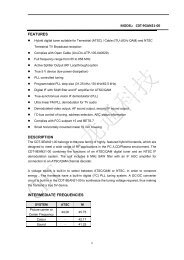
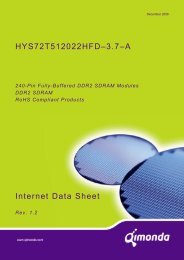

![Internet Data Sheet HY[B/I]39SC128[800/160]FE Rev. 1.1 - UBiio](https://img.yumpu.com/31629373/1/184x260/internet-data-sheet-hyb-i39sc128800-160fe-rev-11-ubiio.jpg?quality=85)
